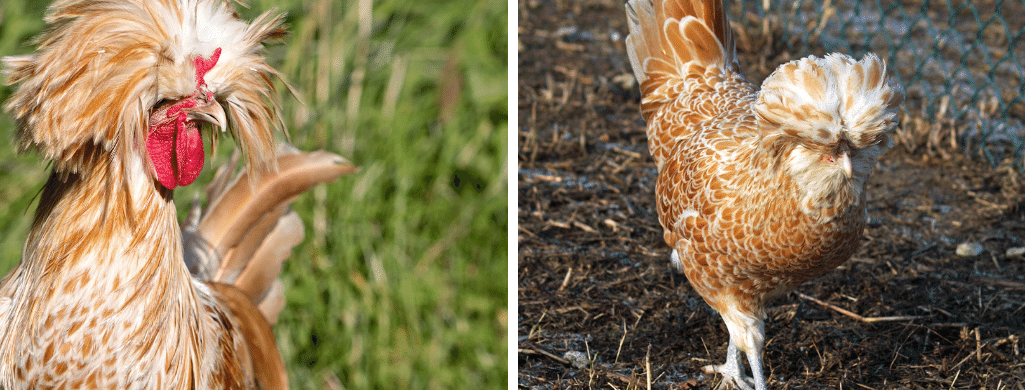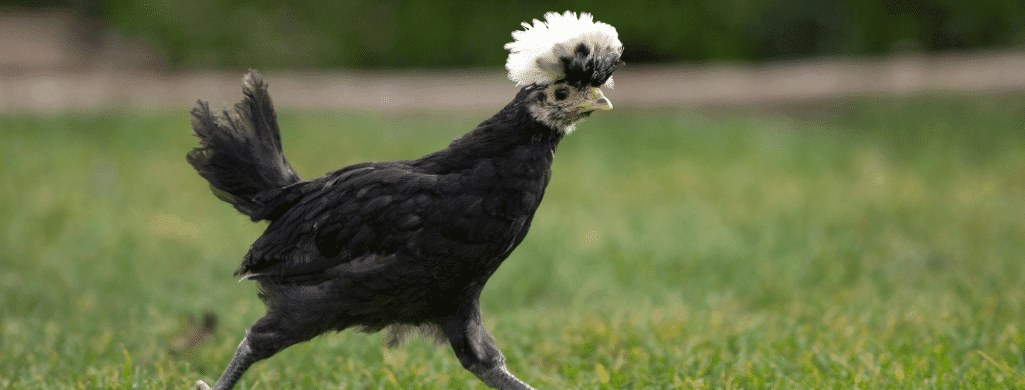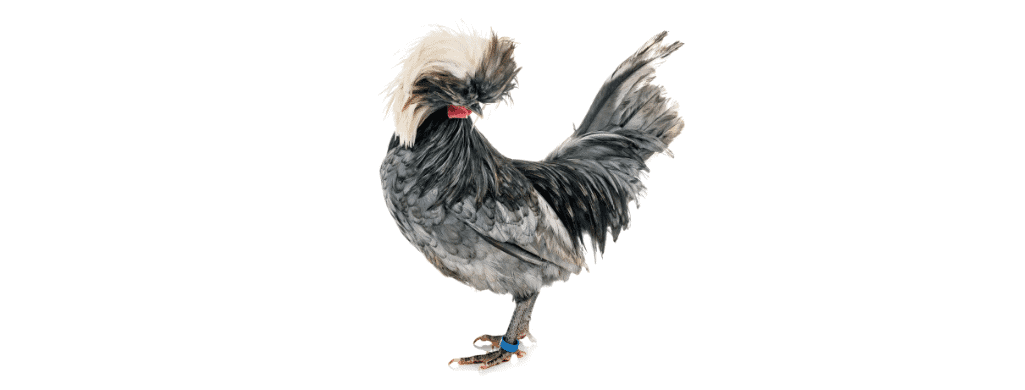Polish chickens are known for their top knots of feathers and unusual appearance.
The puffy crests set the Polish apart from other chicken breeds.
Sexing Polish baby chicks is often tricky, but adults have distinct features.
Understanding the physical differences helps you avoid ending up with too many roosters.
So how do you tell if a Polish chicken is a rooster or a hen?
The easiest way to determine if a Polish chicken is a rooster or a hen is to look at their plumage. Polish hens have rounded feathers on their crest and short, upright tail feathers. The crest feathers on a Polish rooster stand upright, and its tail feathers are long and curved.
Read on to learn more about the differences between Polish roosters and hens.

Table of Contents
ToggleHow To Sex Polish Chicks
While most baby chicks are difficult to sex until they are at least six weeks of age, Polish chicks are much different.
The ideal time to determine the sex of Polish chicks is when they are 1-2 weeks old.
Even at an early age, the crest of a Polish chick is different between sexes.
A Polish female chick has a rounded, puffy crest with a distinct circular shape.
The crest of a Polish male chick is somewhat rectangular, and the feathers are more uneven.
Once Polish baby chicks are two weeks old, they lose their baby fluff.
If you miss the 1-2 week sweet-spot opportunity to identify their sex, you will have to wait until their adult plumage comes in.
It may take 10-12 weeks for the tail and head feathers to develop.
Are Polish Roosters Larger Than Hens?
Like most chicken breeds, Polish roosters are a bit larger than hens.
The average weight for Polish males is about 6-7 pounds, while the females weigh only 4.5-5 pounds.
Polish chickens have a very upright stance; their height is between 12” and 18” inches tall.
The Polish hens will always be a little shorter than the roosters.
Because of their low body weight, Polish chickens are decent flyers.
It is not uncommon to see a Polish chicken roosting on tree branches.
Their ability to fly makes it challenging to keep Polish chickens contained inside a fence.
An adult Polish chicken can fly up to 6’ feet into the air.
Related: Polish Rooster Characteristics
Are Polish Roosters and Hens Different Colors?
Polish chickens come in a wide variety of colors, including:
- White-crested black
- Black-crested white
- Blue
- Buff laced
- Silver laced
- Golden Laced
- White laced red
Black feathers usually have a green sheen.
Both male and female Polish chickens are available in any of these color variations.
There is no distinct difference in the color patterns of either sex.

How Is the Plumage Different in Polish Roosters and Hens?
The feather shape of Polish chickens is different between males and females.
Polish roosters have pointy feathers, while the hens’ feathers are more rounded.
This difference in shape is noticeable on the bird’s head feathers.
The rounded feathers of a Polish hen give the crest a neat, circular shape.
Polish roosters have a wild array of feathers on their crest, making them messy-looking.
This long topknot of feathers sometimes leads to vision issues.
Restricted vision is very dangerous for Polish chickens because it makes them at risk from predators.
If you are not raising these beautiful birds for show purposes, trim their head crests.
Since they are much smaller than other breeds of chicken, you must protect your birds from predators.
It is not unusual for Polish chickens to have extra feathers around their beaks, known as beards.
Bearded Polish chickens come in the same color varieties as non-bearded birds.
Male and female Polish chickens may have beards.
Tail feathers on Polish hens are short and upright.
Polish roosters have long, pointy tail feathers which curve downward.
Some Polish chickens have the frizzle gene.
Frizzle Polish chickens have twisted feathers curling outward instead of lying flat.
Do Both Sexes Have the Frizzle Gene?
Frizzled Polish chickens have a genetic mutation. This gene makes their feathers twisted and fluffy.
Both male and female Polish chickens may carry the frizzle gene.
The frizzled feathers give the Polish chicken an even more unusual appearance.
Sometimes, frizzling causes the feathers to be very brittle.
Frizzle genes are a dominant trait.
If a bird is frizzled, it carries at least one copy of the frizzle gene.
Chickens born with two copies of the frizzle gene usually have fragile feathers. They also suffer from heart problems and other health issues.

Do Polish Hens Have Combs and Wattles?
Polish hens have combs and wattles, but they are much smaller than roosters.
Most of the time, the combs and wattles on hens hide underneath their fluffy plumage.
The Polish chicken has a small, v-shaped comb type.
A bony prominence supports this comb on the top of the head.
In baby chicks, this bony head prominence is not completely closed.
It could die if a Polish baby chick gets attacked on the head.
The bony prominence knits together when Polish chicks are a few weeks old. Once the gap closes, they are no longer in serious danger.
Are Polish Roosters More Aggressive Than Hens?
Polish chickens are a very docile breed, but it is common for the roosters to be more aggressive than hens.
It is not unusual to have an aggressive Polish rooster. Its job is to assert dominance and protect the flock.
Roosters may begin displaying this dominant behavior as young as four months old.
If you have more than one rooster, they may fight.
To avoid fighting, it is best to have no more than one rooster for every ten hens in a flock.
Polish chickens are very gentle birds with friendly personalities.
The beautiful crests of Polish chickens often make them a target for bullying.
If you have a mixed flock, monitoring your birds for signs of bullying is crucial.
It may take several months for the feathers on a Polish chicken’s crest to grow back.
Consider keeping your Polish chickens in a separate pen. This will lower the chances of crest mutilation.
Also, if the bird crows often, it’s more likely to be a rooster too!
Further Reading: Polish chickens and why they crow
Why Are Polish Roosters and Hens Raised?
Polish chickens are classified as an ornamental breed.
The smaller size of Polish chickens makes them less than ideal for meat production.
Further Reading: Can Polish Chickens Be Eaten?
Polish hens are decent egg layers, producing up to 200 eggs annually.
But this is not enough eggs for the hens to be used as commercial egg layers.
Polish chickens have such friendly personalities they are often raised as pets.
The Polish breed is a favorite among backyard chicken keepers because of its unique appearance.
Polish chickens are usually a favorite at poultry exhibitions.
Battle Of The Sexes In Polish Chickens
Polish chickens are beautiful birds with lots of fluffy plumage.
The hens look more refined than the wilder-looking roosters.
If you want a chicken with personality, look no further than the Polish breed.
The Polish chicken is great with children and has a friendly personality.
It’s no wonder why this breed is so popular among backyard flocks!
Read more on tips for raising Polish chickens (they’ll help make things easier!).
How useful was this post?
Click on a star to rate it!
We are sorry that this post was not useful for you!
Let us improve this post!
Tell us how we can improve this post?
